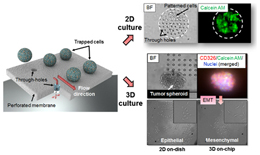生体工学を利用して作製した表面上で構造化可能な2D組織および3Dスフェロイドの培養と上皮-間葉移行特性の獲得
Configurable 2D and 3D spheroid tissue cultures on bioengineered surfaces with acquisition of epithelial–mesenchymal transition characteristics
2012年9月21日 NPG Asia Materials 4, e9 (2012) doi:10.1038/am.2012.50
マイクロチップ:細胞のパターン形成培養

Andrew Wo率いる台湾とシンガポールの研究チームはこのたび、細胞を二次元単層または三次元スフェロイド(球状組織体)に形成して培養できるマイクロ流体チップを作製した。組織のパターン培養法はすでに複数知られているが、それらは概して手順が複雑であったり、細胞廃棄物が相当量出たりしていた。今回、研究チームが考案したマイクロ流体チップは、2つのマイクロチャネルが孔の開いた膜で隔てられている。このチップ上に載せられた細胞は、効率よく捕獲され、膜の孔を覆う細胞外マトリックス分子を慎重に選択することによって、特定のパータン形状に培養される。タンパク質を用いると単層2D細胞パターンが、「プルロニック」界面活性剤ポリマーコーティングを用いると3D多細胞スフェロイドパターンの形成が確認された。3Dパターン形成ではさらに、「上皮」性から「間葉」性への細胞変化が誘発される。こうしたチップは、生物学的過程の研究に応用が見いだされる可能性がある。
Microchips: Patterned cell cultures
A team of researchers based in Taiwan and Singapore, led by Andrew Wo, has constructed a microfluidic chip that enables cells to be cultured into either two-dimensional monolayer or three-dimensional spheroid geometries. Although methods for patterning tissue cultures are known, they typically require complex procedures or involve significant cell waste. The microfluidic chip devised by the researchers is comprised of two microchannels separated by a perforated membrane. Cells loaded onto the chip are efficiently trapped and cultured into specific patterns that are determined by judiciously chosen extracellular matrix molecules used to coat holes in the membrane. Use of a protein or a surfactant ‘Pluronic’ polymer coating led to the formation of a monolayer 2D cellular pattern or a 3D multicellular spheroid one, respectively. Furthermore, 3D patterning induced a change in the cells from ‘epithelial’ towards ‘mesenchymal’ characteristics. These chips may find applications in the study of biological processes.

